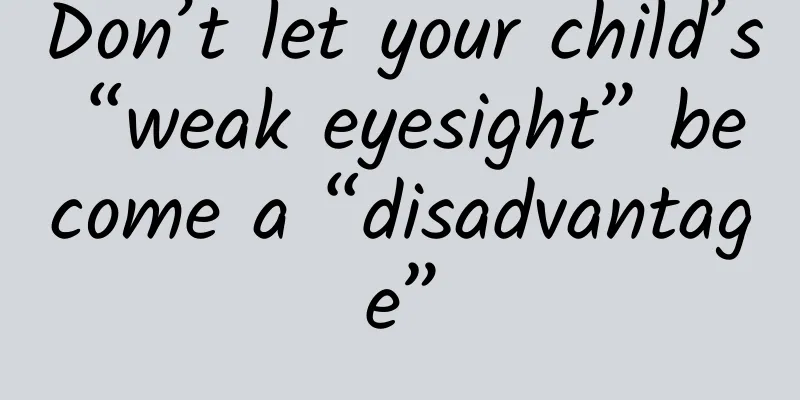Don’t let your child’s “weak eyesight” become a “disadvantage”

|
Author: Hao Rui, deputy chief physician of Tianjin Eye Hospital Reviewer: Zhang Wei, Chief Physician of Tianjin Eye Hospital, Head of the Strabismus and Pediatric Ophthalmology Group of the Ophthalmology Branch of the Chinese Medical Association Competition is everywhere, from the world to human society. The law of natural selection and the survival of the fittest in nature also applies to the development of human vision. Humans have two eyes, so competition between the eyes is innate. The ideal situation is to develop synergistically and keep pace with each other in competition. However, where there is competition, there may be advantages and disadvantages. When the eyes show a tendency of "competition" in "growth", the "advantages" and "strengths" of vision will be revealed. Figure 1 Copyright image, no permission to reprint After human beings are born, the development of vision accompanies the growth of the human body and is a long-lasting process lasting several years. Clear eyes are not innate. Each developmental stage has a vision development standard corresponding to the corresponding age. To measure whether a child's vision development is normal, we should refer to the lower limit of the normal value of vision development corresponding to the corresponding age. If the vision is lower than this standard, or the difference in vision between the two eyes exceeds 2 lines, is it definitely "amblyopia"? Figure 2 Copyright image, no permission to reprint The vision we talk about in daily life is not necessarily the best corrected vision in professional terms. The acquisition and evaluation of best corrected vision needs to be carried out in a hospital or professional institution. An ophthalmologist will conduct a comprehensive eye examination and ciliary muscle paralysis (i.e. "mydriasis"), which can only be determined after a professional optometrist performs retinoscopy. To determine whether a child has "amblyopia", it is necessary to comprehensively consider the child's age, eye examination results, and the results of retinoscopy after ciliary muscle paralysis. For children with poor cooperation, the results of a single examination may not be fully explained or may be inaccurate, and close follow-up is required. Once risk factors that affect visual development are found, active intervention should be carried out as soon as possible to promote the coordinated development of binocular vision. Figure 3 Copyright image, no permission to reprint So, what is "amblyopia"? Why does "amblyopia" occur? In fact, it is not difficult to understand the occurrence of amblyopia if you understand the process of visual development. my country's 2011 "Amblyopia Diagnosis Expert Consensus" clearly pointed out that during the visual development period, the best corrected visual acuity of one or both eyes is lower than the visual acuity of the corresponding age due to monocular strabismus, uncorrected anisometropia, high refractive error and form deprivation; or the visual acuity of the two eyes differs by 2 lines or more, and the lower visual acuity eye is amblyopia. Figure 4 Copyright image, no permission to reprint In other words, only when there are risk factors that affect visual development and they do affect visual development can a diagnosis of amblyopia be made. The Expert Consensus on Amblyopia Diagnosis also emphasizes that if the visual acuity is not lower than or slightly lower than the lower limit of normal visual acuity for children of the same age, and no risk factors related to amblyopia are found, close observation should be made and amblyopia should not be hastily diagnosed. After "amblyopia" is diagnosed, if no intervention is made, it is likely to become a "weak point" for the child, just like the short board of a wooden barrel. Humans have two eyes, which is not just a simple superposition of the functions of the two eyes. It also requires the coordinated work of both eyes, and the requirements for the vision and binocular vision of both eyes are very high. The vision of both eyes emphasizes clarity, while binocular vision pays more attention to synergy. One is "division of labor" and the other is "cooperation". First of all, each must perform its duties, and then the strong can join forces. And "division of labor" is the basis of "cooperation". If it is "jumping on one leg", then there is no "cooperation", let alone "strong combination" and "keep improving". Therefore, vision is the basis of binocular vision. The existence of "amblyopia" will destroy the basis of binocular "cooperation", thereby affecting the development of binocular vision. This influence cannot be reversed after a certain age, which causes regrets. Figure 5 Copyright image, no permission to reprint So, what should you do if you really have "amblyopia"? First, you need to find out the relevant risk factors that cause amblyopia, and then carry out targeted treatment. If you have refractive errors, anisometropia, etc., you should actively wear glasses to correct them; if there are form deprivation factors (such as severe ptosis, etc.), you should also intervene and treat them as soon as possible. If it is amblyopia in one eye, combined occlusion or suppression therapy may be required. The specific treatment method needs to be comprehensively judged based on factors such as the child's age, eye examination results, eye position, retinoscopy results after ciliary muscle paralysis, the type of amblyopia, and whether there is nystagmus. The treatment of amblyopia is a long and lasting process that requires regular follow-up, parental cooperation, and patient guidance and encouragement. A thousand miles can be achieved with a single step. Children's eye health requires the attention of the whole society and the cooperation of every family. Let us protect the future of our country! |
<<: Too much salt means loss? Start by reducing salt intake to unlock a healthy life
Recommend
How to practice Tai Chi with intention instead of force? What is the Qi sensation when practicing Tai Chi?
There are many schools of Tai Chi. The most commo...
How to replenish qi and blood deficiency in pregnant women? It turns out that these four recipes
There are two ways of giving birth for women: nat...
What nutrients does prune peel contain? How to choose prunes
Prunes are not just a snack, they can be made int...
Can I breastfeed if I have hyperthyroidism?
It is also a headache for mothers if they get sic...
I have a small polyp on my genitals, it doesn't hurt or itch
Small polyps appearing in female genitals may be ...
Use gynecological gel to expel tofu residue
For ladies, it is very important to protect your ...
Is vitamin C effective in removing freckles?
Vitamin C is the abbreviation of vitamin C, which...
How to exercise in late pregnancy to help you have a normal birth
I believe that many women are afraid of childbirt...
Waking up in the middle of the night during early pregnancy
The most outstanding and beautiful person in the ...
Why do women feel hot when they wake up in the morning?
As we all know, the temperature is obviously lowe...
Breast cancer pathological classification
Breast cancer is a disease that is the same as ot...
How did Jin Jun Mei get its name? How to distinguish good from bad Jin Jun Mei
Good Jin Jun Mei tea has a golden, brown, silver ...
The harm of female endocrine disorders
Endocrine disorders have a great impact on the bo...
Original popular science article: Scientifically prevent and treat stroke and enjoy good health
Editor: Ma Yonglan Reviewer: Yang Pengbin (Xu Aiq...
How do women determine whether they are sexually indifferent?
Sexual indifference is not gender specific. In ad...









